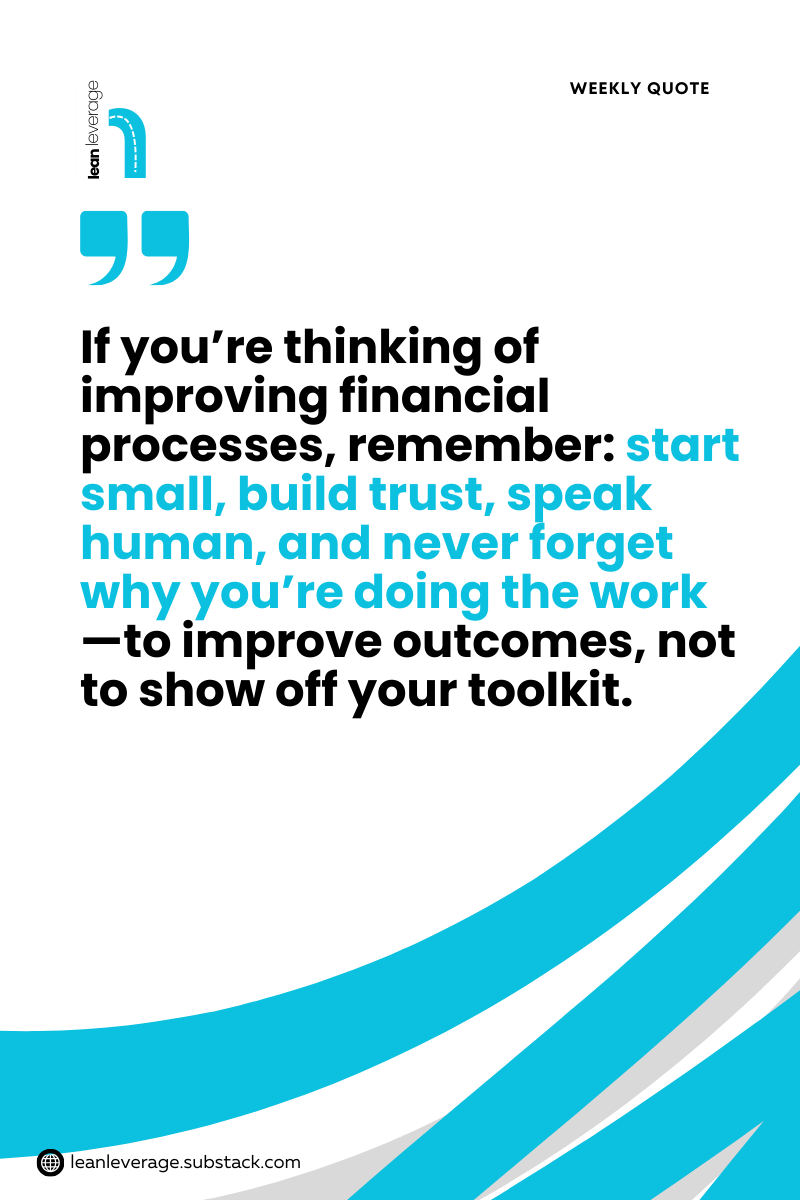Lean Improvements in the “Finance Space”
Lean has a seat at the table in finance, just like it does in healthcare, manufacturing, and everywhere else.
Hi friends,
I’m back! After a much-needed two-week break from writing, I’m excited to return to The Lean Leverage Hub. There’s a Yoruba proverb that says, "Ojó ikú, l’ojó ìsinmi."—“The day we die is when we rest.” Honestly, I thought I’d rest during my break, but life had other plans. I had a few personal challenges that needed attention (adulthood na scam), but thankfully, they’ve been resolved.
Now, let’s get into today’s post.
Why Finance?
At the start of the year, one of my goals was to deepen my understanding of the finance world. So I’ve been reading a lot and asking my friends in the industry lots of questions—corporate finance, mergers and acquisitions, capital markets, bonds, stocks, funds, portfolio management… the whole shebang.
You might be wondering, “Why finance, though?” Simple. I’m genuinely curious about the space. It’s heavily regulated (just like healthcare, where I currently work), and let’s be honest—every human being needs some level of financial literacy.
Can Lean Be Adopted in Finance?
Absolutely.
Every organisation, whether profit-driven or not, has a financial side. Even charities that collect donations have to manage money. So, technically, every business is a little bit in finance.
Now, when we say “financial organisations,” we’re talking about businesses that live and breathe money—think banks, lenders, investment firms, mortgage brokers, and fintech companies like Paystack and Flutterwave. And yes, let’s not forget the insurance industry—my wife’s absolute favourite corner of finance.
The good news is that all these organisations can benefit from Lean just as much as hospitals, factories, or call centres. Whether it’s reducing waste, improving customer experience, speeding up processes, or financial improvement—Lean delivers.
For example:
Loan Processing
If it takes two weeks to process a loan, Lean can help identify and eliminate theunnecessary steps causing delays. Maybe the process is too manual, or approvals go through ten people before landing on someone who can say “yes”. That’s muda (waste), and Lean was born to fight it.
Policy Renewal in Insurance
Ideally a customer should get a clear reminder just before their policy expires, an easy renewal path, maybe even a nudge about added benefits. But often, the process is manual—someone in the back office sends reminders late, or worse, the system doesn’t flag renewals properly. The customer slips away to a competitor with a smoother process.Lean can help insurance teams map out the renewal process, identify where the handoffs or system lags are, and automate timely reminders or offers. This reduces customer churn and saves the team from firefighting every renewal cycle.
So yes, Lean works here too.
But It’s Not All Smooth Sailing
Just like owning a car in Lagos — helpful, but with its own stress — implementing Lean in finance comes with its own challenges.
Regulations Everywhere
Working in healthcare has taught me something vital: you don’t just change a process because you think it’s better. Patients come first, second, third, and your brilliant ideas are number 99 on the list. The same applies in finance. From compliance to anti-money laundering laws, everything has a regulation attached to it.
What to do? Work closely with compliance teams from Day 1. Don’t wait till you’ve mapped out a fancy new process before checking if it’s even legal.Money = Risky Business
Let’s not lie—people are more cautious when money is involved, especially if it’s not their own. Finance leaders are often hesitant to make changes or adopt new things that could cause even the slightest financial error.
What to do? Start small. Prove the value of improvement in low-risk areas, then build trust before tackling bigger systems.It’s a Global Playground
Unlike healthcare systems that tend to operate within one country (like the NHS in the UK), financial services often work across borders. That means policy,cultural, legal, and language barriers. What works in Lagos may not fly in Lisbon.
What to do? Collaborate with cross-functional and cross-regional teams. Understand the nuances before designing or rolling out changes.
How to Win with Lean in Finance
If you want to succeed as a Lean or Six Sigma expert in finance, here’s the real tea: Don’t come in acting like you’re about to “fix everybody.” Approach each challenge with humility and curiosity. Learn the regulatory context, speak to those who do the work, and build relationships with the compliance and legal teams.
Your job isn’t just to apply tools—it’s to solve problems and create value without breaking the system.
And please, leave the jargon at home. Speak plainly, show empathy, and always keep the customer at the centre of it all. Lean isn’t about being smart—it’s about making sense.
Final Thoughts
Lean has a seat at the table in finance, just like it does in healthcare, manufacturing, and everywhere else. But like every good guest, it needs to respect the house rules. If you’re thinking of improving financial processes, remember: start small, build trust, speak human, and never forget why you’re doing the work—to improve outcomes, not to show off your toolkit.
Until next time, keep improving.
– Tomiwa
Lean Process Improvement Enthusiast
(Still wondering if I should’ve studied finance earlier in life…)




